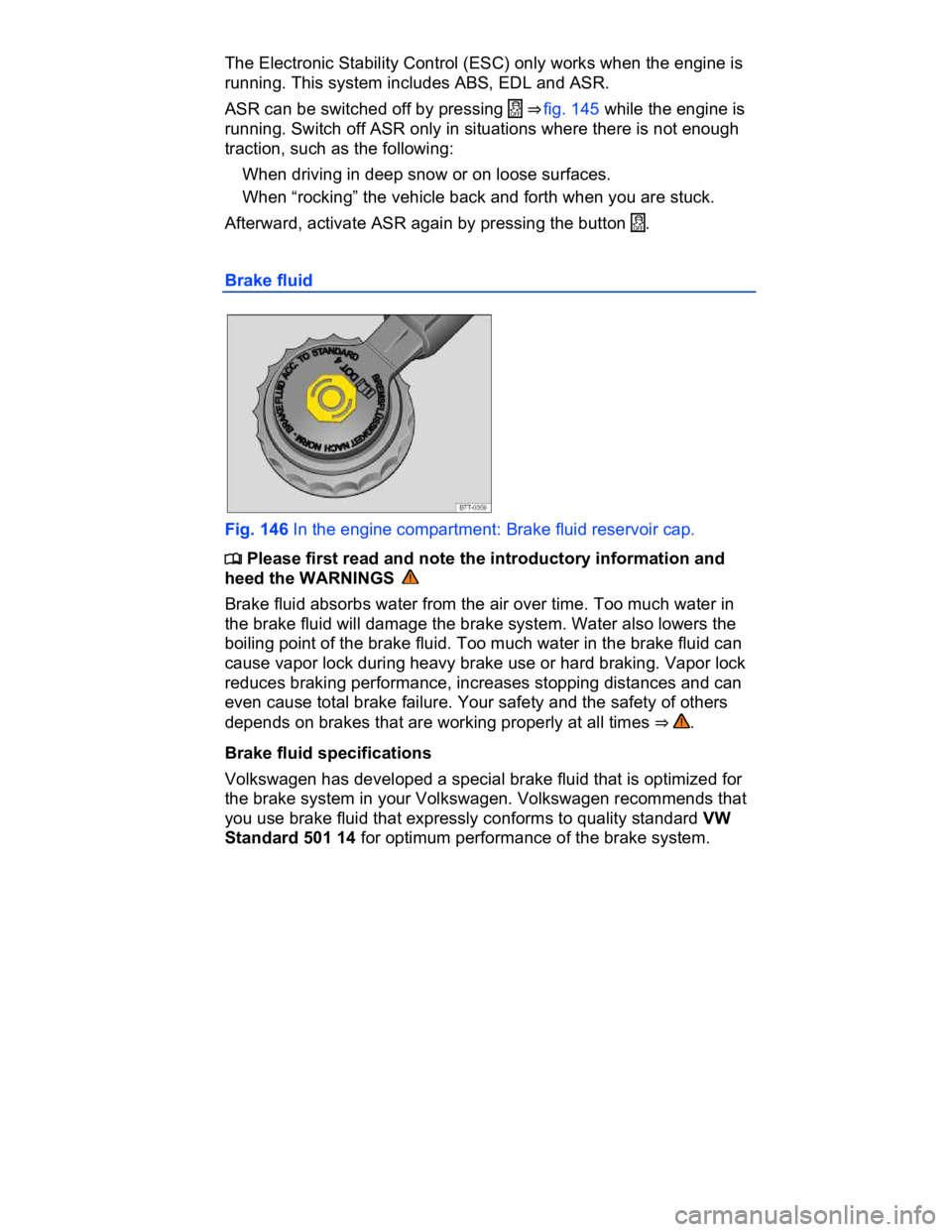2008 VOLKSWAGEN CC ABS
[x] Cancel search: ABSPage 136 of 578

Safety belts attach passengers to the car and give them the benefit of
being slowed down more gently or “softly” through the “give” in the
safety belts, crumple zones, and other safety features (such as air-
bags) engineered into today's vehicles. The front crumple zones and
other passive safety features (such as the airbag system) are also
designed to absorb kinetic energy. By “absorbing” the kinetic energy
over a longer period of time, the forces on the body become more
“tolerable” and less likely to cause injury.
Although these examples are based on a frontal collision, safety belts
can also substantially reduce the risk of injury in other kinds of crash-
es. So, whether you're on a long trip or “just going to the corner
store,” always buckle up and make sure that others do, too.
Accident statistics show that vehicle occupants properly wearing safe-
ty belts have a lower risk of being injured and a much better chance
of surviving a collision. Properly using safety belts also greatly in-
creases the ability of the supplemental airbags to do their job in a
collision. For this reason, wearing a safety belt is required by law in
most countries including the United States and Canada.
Although your Volkswagen is equipped with airbags, you still have to
wear the safety belts provided. Front airbags, for example, are acti-
vated only in some frontal collisions. The front airbags are not acti-
vated in all frontal collisions, in side and rear collisions, in rollovers, or
in cases when the conditions for deployment stored in the electronic
control unit are not met. The same goes for the other airbag systems
on your Volkswagen.
So always wear your safety belt and make sure that everybody in
your vehicle is properly restrained!
Using safety belts
�
Page 188 of 578

WARNING
Driving with an open luggage compartment lid can cause poi-
sonous carbon monoxide in the engine exhaust to get into the
passenger compartment.
� Carbon monoxide causes drowsiness, inattentiveness, poi-
soning, and loss of consciousness. It can lead to accidents and
severe personal injuries.
� Always keep the luggage compartment lid closed while driv-
ing to help keep poisonous exhaust fumes from being drawn
into the vehicle.
� Never transport objects that are too large to fit completely
into the luggage area, because then the luggage compartment
lid cannot be fully closed.
� If you absolutely must drive with an open luggage compart-
ment lid, do the following to reduce the risk of carbon monox-
ide poisoning:
– Close all windows and the power sunroof.
– Switch off the climate control system's air recirculation fea-
ture.
– Open all air vents in the instrument panel.
– Set the fresh air fan to the highest speed.
NOTICE
The open luggage compartment lid changes the vehicle height.
Driving a loaded vehicle
�
Page 335 of 578

Lights
up
Possible cause or
meaning ⇒ Proper response
Together with ABS indica-
tor light �J or �!�"�3: ABS fail-
ure.
See an authorized
Volkswagen dealer or an au-
thorized Volkswagen Service
Facility.
The vehicle brakes will work
without ABS.
�"�2�!�+�%
�7�%�!�2
Brake pads worn.
If you believe that it is safe to
do so, immediately take the
vehicle to an authorized
Volkswagen dealer or author-
ized Volkswagen Service Fa-
cility. Check, and if necessary
replace, all brake pads.
�I
�
Page 338 of 578

WARNING
Driving with bad brakes can cause a collision and serious per-
sonal injury.
� If the brake warning light �"�2�!�+�% or �H does not go out, or
comes on when driving, either the brake fluid level in the reser-
voir is too low or there is a fault in the brake system. Stop the
vehicle as soon as you can do so safely and get expert assis-
tance ⇒ Brake fluid.
� If the brake warning light �"�2�!�+�% or �H comes on at the same
time as the ABS warning light �!�"�3 or �J, the ABS may not be
working properly. This could cause the rear wheels to lock up
relatively quickly during braking. Rear wheel brake lock-up can
cause loss of vehicle control.
� If you believe the vehicle is safe to drive, drive slowly and
very carefully to the nearest authorized Volkswagen dealer, au-
thorized Volkswagen Service Facility, or other qualified work-
shop and have the brake system inspected. Avoid sudden hard
braking and steering.
� If the ABS indicator light �!�"�3 or �J does not go out, or if it
comes on while driving, the ABS system is not working proper-
ly. The vehicle can then be stopped only with the standard
brakes (without ABS). You will not have the protection ABS
provides. Contact your authorized Volkswagen dealer or an au-
thorized Volkswagen Service Facility as soon as possible.
� If the symbol �"�2�!�+�% �7�%�!�2 or �I lights up in the instrument clus-
ter display, whether alone or together with a text message, im-
mediately contact an authorized Volkswagen dealer or author-
ized Volkswagen Service Facility to have the brake pads
checked and, if necessary, replaced.
NOTICE
Failure to heed warning lights or text WARNINGS can result in
vehicle damage.
Page 347 of 578

help keep the vehicle going in the intended direction. If you are travel-
ing at a speed that causes you to run off the road before ESC can
provide any assistance, you may not experience the benefits of ESC.
ESC includes and/or works together with the ABS, BAS, ASR, EDL,
and XDL systems (see below). ESC is switched on all the time. In
certain situations when you need less traction or additional traction
cannot be achieved, you can switch off ASR by pressing the �m button
⇒ fig. 145. Be sure to switch ASR on again when you no longer need
less traction.
Anti-Lock Brake System (ABS)
ABS helps to keep the wheels from locking up and helps to maintain
the driver's ability to steer and control the vehicle. This means the
vehicle is less likely to skid, even during hard braking:
� Push the brake pedal down hard and hold it there. Don't take your
foot off the pedal or reduce the force on the pedal!
� Do not “pump” the brake pedal or let up on it!
� Steer the vehicle while pushing down hard on the brake pedal.
� ABS stops working if you release or let up on the brake.
When ABS is doing its job, you will notice a slight vibration through
the brake pedal and hear a noise. ABS cannot shorten the stopping
distance under all conditions. The stopping distance may even be
longer, for instance, when driving on gravel or on newly fallen snow
covering an icy or slippery surface.
Brake Assist (BAS)
The Brake Assist System can help to reduce stopping distances. If
you press the brake pedal very quickly, BAS detects an emergency
situation. It then very quickly builds up full brake system pressure,
maximizing braking power and reducing the stopping distance. This
way, ABS can be activated more quickly and efficiently.
Do not reduce pressure on the brake pedal! BAS switches off auto-
matically as soon as you release or let up on the brake.
Anti-Slip Regulation (ASR)
ASR reduces engine power directed to spinning wheels and adjusts
power to the road conditions. Even under poor road conditions, ASR
can make it easier to get moving, accelerate, and climb hills.
Page 349 of 578

WARNING
Driving fast on icy, slippery, or wet roads can lead to a loss of
control and result in serious personal injury for you and your
passengers.
� Always adjust your speed and driving style to road, traffic,
weather, and visibility conditions. Never let the additional safe-
ty that ESC, ABS, BAS, ASR, and EDL can provide tempt you
into taking extra risks.
� Braking assistance systems cannot overcome the laws of
physics and always prevent loss of vehicle control. Slippery
and wet roads are still dangerous even with ESC and the other
systems!
� Driving too fast on wet roads can cause the wheels to lose
contact with the road and “hydroplane.” A vehicle that has lost
road contact cannot be braked, steered, or controlled.
� These systems cannot reduce the risk of accident, for exam-
ple if you drive too fast for conditions or if you do not keep
your distance from the vehicle in front of you.
� Although these systems are very effective and can help you
control the vehicle in many difficult situations, always remem-
ber that your vehicle handling control is limited by tire traction.
� When accelerating on a slippery surface, for example on ice
and snow, depress the accelerator carefully. Even with these
systems, the wheels may start to spin, leading to a loss of vehi-
cle control.
Page 350 of 578

WARNING
The effectiveness of ESC can be significantly reduced if other
components and systems that affect vehicle dynamics, includ-
ing but not limited to brakes, tires, and other systems men-
tioned above, are not properly maintained or functioning.
� Always remember that vehicle alterations or modifications
can affect the functioning of the ABS, BAS, ASR, EDL, and ESC
systems.
� Changing the vehicle suspension or using an unapproved
tire/wheel combination can change the way the ABS, BAS, ASR,
EDL, and ESC systems work and reduce their effectiveness.
� The effectiveness of ESC is also determined by the tires fitted
⇒ Tires and wheels.
All 4 wheels must be equipped with identical tires in order for
ESC and ASR to work properly. Differences in the tread circumfer-
ence of the tires can cause the system to reduce the engine power
when it is not expected.
If ABS is not working, ESC, ASR, and EDL will also not work.
You may hear noises when these systems are active.
Switching Anti-Slip Regulation (ASR) on and off
Fig. 145 In the center console: Button for switching ASR on and off
manually.
�
Page 351 of 578

The Electronic Stability Control (ESC) only works when the engine is
running. This system includes ABS, EDL and ASR.
ASR can be switched off by pressing �m ⇒ fig. 145 while the engine is
running. Switch off ASR only in situations where there is not enough
traction, such as the following:
� When driving in deep snow or on loose surfaces.
� When “rocking” the vehicle back and forth when you are stuck.
Afterward, activate ASR again by pressing the button �m.
Brake fluid
Fig. 146 In the engine compartment: Brake fluid reservoir cap.
�